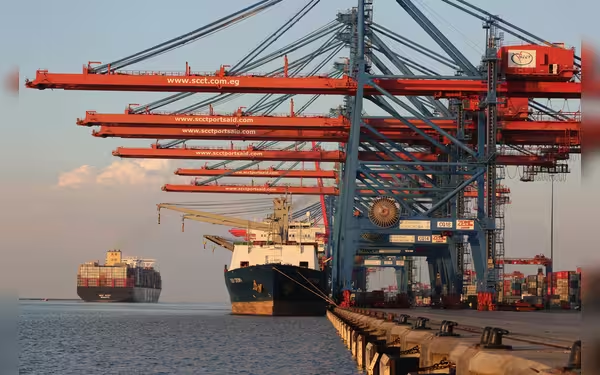Saturday, November 16, 2024 03:21 PM
Saudi Arabia's Container Traffic Surges 14.6% in 2023
- Saudi ports see 14.6% rise in container traffic.
- King Fahad Industrial Port handles 89.8 million tonnes outbound.
- Passenger traffic increases by 11.5% in 2023.
 Image Credits: arabnewspk
Image Credits: arabnewspkSaudi Arabia's ports experience a 14.6% rise in container traffic in 2023, reflecting robust trade and economic diversification efforts.
In recent years, Saudi Arabia has been making significant strides in enhancing its trade and logistics capabilities. The Kingdom's ports have become vital hubs for both inbound and outbound cargo, reflecting the nation’s commitment to economic diversification and growth. According to the General Authority for Statistics (GASTAT), 2023 has marked a remarkable year for Saudi ports, with a reported 14.6 percent increase in container traffic compared to the previous year.
Official data reveals that inbound container traffic at Saudi ports reached an impressive 3.4 million twenty-foot equivalent units (TEUs) in 2023. Meanwhile, outbound traffic totaled 2.2 million TEUs, showcasing the Kingdom's robust export activities. The total quantity of outbound cargo amounted to 203.5 million tonnes, indicating a strong upward trend in Saudi Arabia's exports, particularly in non-oil goods. This is crucial for the Kingdom as it seeks to reduce its reliance on oil revenues and diversify its economy.
Among the ports, King Fahad Industrial Port in Yanbu stood out by handling the largest volume of outbound cargo, totaling 89.8 million tonnes. This port's performance underscores its strategic importance in facilitating trade. On the other hand, Jeddah Islamic Port managed the largest share of inbound cargo, handling 38.9 million tonnes of imports, further solidifying its role as a key player in the region's logistics network.
GASTAT also reported a significant 33.8 percent rise in ship traffic at Saudi ports in 2023, with a total of 19,082 ships recorded. King Fahad Industrial Port again led the way with 6,538 ships, followed by Jeddah Islamic Port and King Abdulaziz Port in Dammam. This increase in ship traffic not only reflects the growing trade activities but also highlights the efficiency and capacity of Saudi ports to handle larger volumes of maritime traffic.
In terms of total cargo handled, Saudi ports managed an impressive 334 million tonnes in 2023. This included 121.3 million tonnes of unloaded cargo and 213 million tonnes of loaded cargo. Jeddah Islamic Port recorded the highest unloaded cargo volume at 38.9 million tonnes, while King Fahad Industrial Port led in loaded cargo with 89.8 million tonnes. These figures illustrate the dynamic nature of the Kingdom's trade operations.
Passenger traffic at the Kingdom’s ports also saw a notable increase of 11.5 percent in 2023, with over 1 million travelers arriving and departing. Jazan Port emerged as the busiest for passenger traffic, handling 484,598 travelers. This growth in passenger movement indicates a thriving tourism sector and the importance of ports in facilitating travel.
Furthermore, the report highlighted that the number of cranes at Saudi ports reached 989 in 2023, and the total area covered by the Kingdom’s ports was 104 square kilometers, with Ras Al Khair Port being the largest at 23 square kilometers. These statistics not only reflect the scale of operations but also the ongoing investments in infrastructure to support future growth.
The impressive rise in container traffic and overall cargo handling at Saudi ports in 2023 is a testament to the Kingdom's strategic efforts in enhancing its trade capabilities. As Saudi Arabia continues to diversify its economy and reduce its dependency on oil, the growth of its ports will play a crucial role in shaping the future of its trade landscape. This positive trend not only benefits the economy but also positions Saudi Arabia as a key player in global trade, paving the way for further opportunities and partnerships in the years to come.













